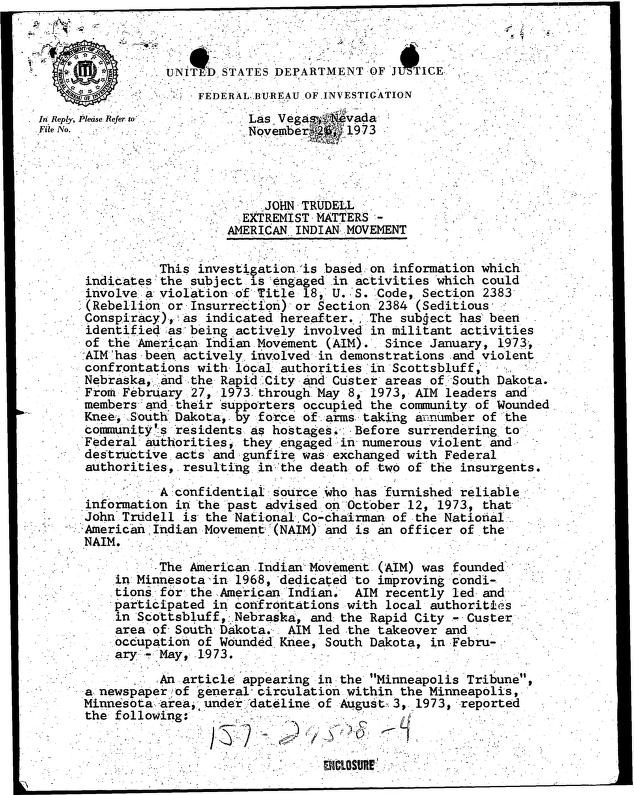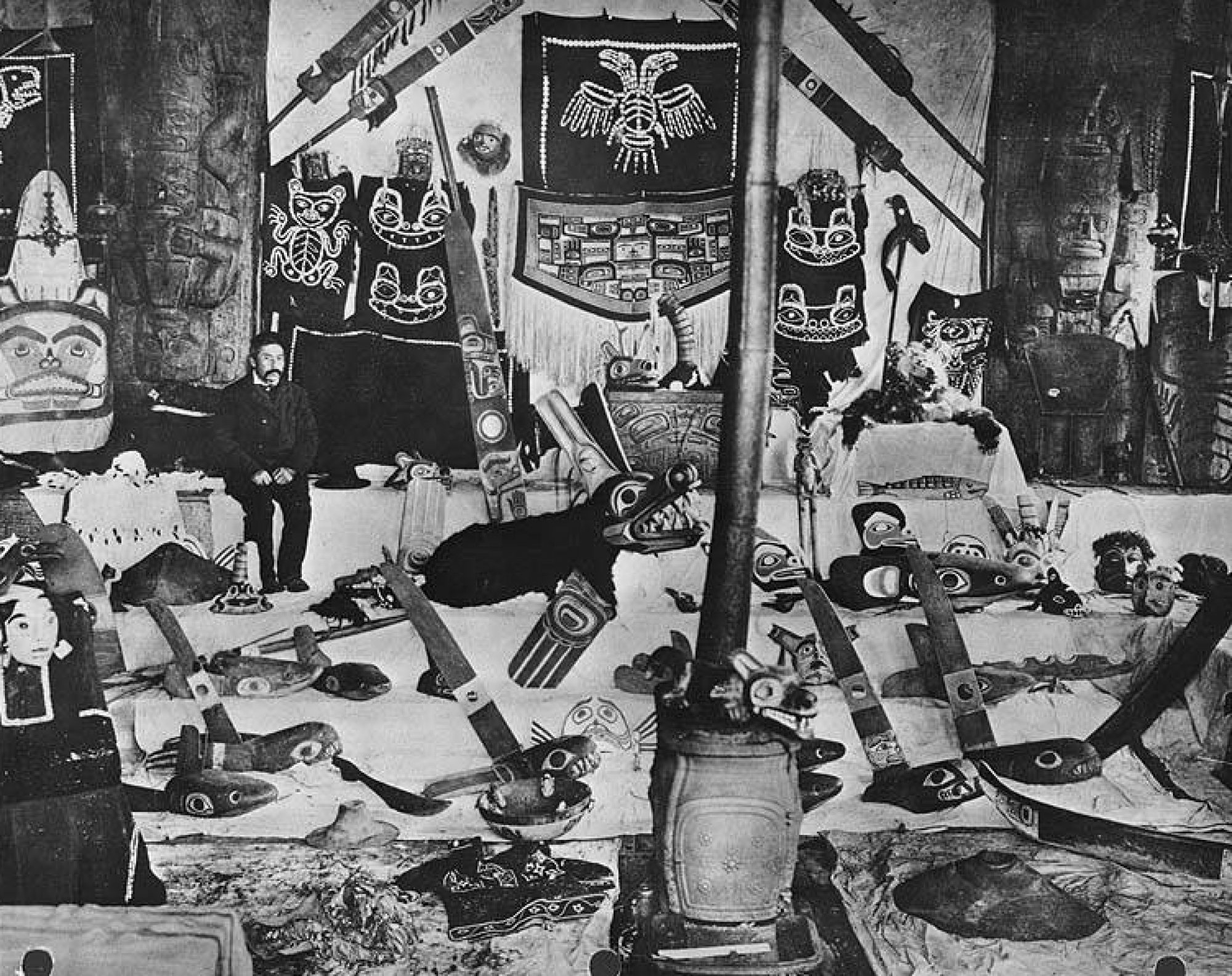Biographical Timeline | Leadership Qualities | Tibetan Language Erasure | References
John Trudell – Leadership Qualities
Biographical Timeline | Leadership Qualities | OK Tribal Gaming Dispute | References
Inspiring
John Trudell was and continues to be an inspiration to Native American activists across the globe. He created an image and a brand that “made the spirit of the people stronger.” He was able to unite generations of Native Americans because his music and poetry drew on traditional Native American styles and themes that older generations could connect with, while incorporating modern characteristics that younger people could relate to as well. His music worked to preserve part of his cultural heritage and inspired people to connect deeper with their roots. Not only did he reach across the age gap, but across the gender gap as well. In his time with AIM John was constantly advocating for the voices of women to be heard, because he felt that they were so often lost in the crowd. He was a particularly strong advocate for the agency of his wife. After her death he made sure that people knew the amazing work that she had done, that her death was not simply defined by his work, but by her own advocacy for Native American rights and sovereignty as well.
Charismatic
People were inspired by John because they were drawn to him, he was powerful in the way that he could draw crowds when speaking at events. His charisma is what gathered the attention of federal agencies, and even frightened them and caused them to label him as dangerous. John did not back down from his beliefs or ideals and he challenged and criticized those who were lacking in upholding their own morals and beliefs. The US government was a main recipient of his criticism because he argued that they not only lacked care for their own people, but for the planet they lived on as well. During the Alcatraz occupation John fought to protect the rights of ALL Native Americans, and would not be paid off in order to back down from his beliefs. He burned an American flag on the steps of the FBI building because he said it was desecrated by the racism, classism and sexism that it represented. The American flag did not represent freedom in John’s eyes because not all were free.
Courageous
There were many instances in which John Trudell should have been afraid for his life, but nevertheless he upheld his values and kept fighting for what he knew was right. During the Civil Rights Movement in the 1960s the FBI began a program called COINTEL, which aimed to shut down the movement, but when AIM began vamping up as a political player they shifted their focus to John Trudell himself. His active involvement in the Alcatraz occupation and other sit ins at Wounded Knee and the BIA placed a target on his back. The FBI feared John because of his ability to motivate and mobilize not only Native Americans, but non-natives as well, as seen at Wounded Knee. AIM was eventually labeled as a militant terrorist group at the Wounded Knee protests, which was a way to enable and excuse violence against the activists there. One of the more terrifying moments in his life came with the death of his wife, mother-in-law and three children after burning an American flag atop the FBI steps. Although the fire that killed his family was ruled as an accident, John was certain it was murder. This moment in time was a sure indicator that if someone could kill people as innocent as his family, they could surely kill him.

Leanne Betasamosake Simpson – Colonial Gender Violence
Biographical Timeline | Leadership Qualities | Colonial Gender Violence | References

During the Assembly of First Nations (AFN) special chiefs gathering in Gatineau, Québec in early 2016, the Liberal leader announced that his government had begun the process to create the inquiry into the nearly 1,200 indigenous women and girls who have been murdered or who have gone missing in Canada over the past three decades. Across Canada, activists, aboriginal leadership and many of the families of missing or murdered Aboriginal women have been calling for a national inquiry for more than a decade. First Nations Communities have been seeking to ensure a safe and violence-free future for all Aboriginal bodies across Canada. The previous Prime Minister, Stephen Harper, failed to take any action to investigate these decades of genocide towards First Nations Canadian women and Two-Spirit people. It is critical for our Canadian Government to consult with victims’ families and Aboriginal leaders to gather the views of our First Nations people on the design, scope, and parameters of the full inquiry of the murders and missing First Nations women across Canada. Aboriginal women make up just 4% of Canada’s female population but constitute the staggering rate of 16% of all women murdered in the country. First Nations, Inuit and Metis women are three times more likely to report experiencing violence. The Canadian justice system itself is responsible for perpetuating violence against Aboriginal bodies and has been set up to serve a society built on Indigenous erasure. Law enforcers are often the offenders/perpetrators of these crimes committed.
Leanne Simpson addresses this epidemic of colonial gender violence throughout Indian Country in Not Murdered, Not Missing: Rebelling Against Colonial Gender Violence. Simpson begins by explaining, “White supremacy, rape culture, and the real and symbolic attack on gender, sexual identity and agency are very powerful tools of colonialism, settler colonialism and capitalism, primarily because they work very efficiently to remove Indigenous peoples from our territories and to prevent reclamation of those territories through mobilization. These forces have the intergenerational staying power to destroy generations of families, as they work to prevent us from intimately connecting to each other. They work to prevent mobilization because communities coping with epidemics of gender violence don’t have the physical or emotional capital to organize. They destroy the base of our nations and our political systems because they destroy our relationships to the land and to each other by fostering epidemic levels of anxiety, hopelessness, apathy, distrust and suicide. They work to destroy the fabric of Indigenous nationhoods by attempting to destroy our relationality by making it difficult to from sustainable, strong relationships with each other.” Leanne then suggests that it is in our best interests to approach this issue of gender violence as a core resurgence project, a core decolonization project, a core of any Indigenous mobilization. She makes it clear that she is addressing violence against all genders, including the high rates of violence perpetuated against two-spirit/queer Indigenous bodies. Women and Two-Spirit/LGBTQ2 peoples are both at higher risks of being subjected to violence within the structure of settler colonialism. Leanne breaks this down by explaining that one of the many tactics of the colonizer is to use gender violence to remove Indigenous peoples and their descendants from the land, then remove agency from the plant and animal worlds and re-positioning the land as a resource to be used by the colonizer.
Leanne Simpson then states that movements such as Idle No More, where women are on the front lines cannot be used to abolish this violence. Throughout history and continuing to present day, we see that gender violence is the colonial response to Indigenous resistance. Simpson creates a consensus to avoid putting Indigenous women leaders and activists at risk when working to eliminate this violence. Leanne Simpson states, “We must build criticality around gender violence in the architecture of our movements. We need to build communities that are committed to ending gender violence and we need real world skills, strategies and plans in place, right now, to deal with the inevitable increase in gender violence that is going to be the colonial response to direct action and on going activism. We need trained people on the ground at our protests and our on the land reclamation camps. We need our own alternative systems in place to deal with sexual assault at the community level, systems that are based on our traditions and do not involve state police and the state legal system. Her end goal is working towards building Indigenous communities where all genders stand up, speak out and are committed to both believing and supporting survivors of violence and building Indigenous transformative systems of accountability. The answer is within the community to work to protect its women and two-spirit members, we cannot look to the state which is the largest perpetrator of gendered violence to solve this issue.
On speaking out about Gender Violence towards Indigenous women, Leanne Simpson claims that the situation is infuriating. Simpson views the situation as one that impacts every Indigenous person. Leanne Simpson states, “It ends here for Loretta, Bella and all of the other brilliant minds and fierce hearts we’ve lost. It ends here. This is my rebellion. This is my outrage. This is the beginning of our radical thinking and action.” Simpson knows that her reactions to such an event are driven on pure emotion but she is diplomatic- using emotion to drive her activism home when it comes to gender violence. Simpson educates and explains why everyone should feel upset and horrified at the murders. She gives her audience the room to become emotional and driven to make a change in a society where emotional involvement is invalidated.
